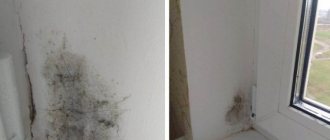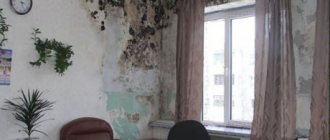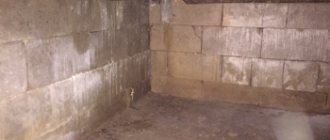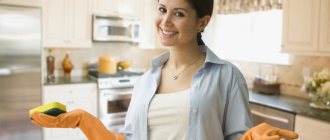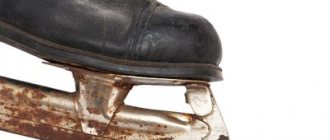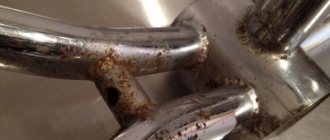My respect to all readers and visitors of the “Secrets of the Master” site! When I was young, I lived in an apartment on the fifth floor and mold appeared in our kitchen in the corner of the outer wall of the house after we started drying baby diapers in the winter. This means that the first reason for the appearance of fungus on the walls is the increased humidity of the room, which does not go away for a long time. The second reason is poor ventilation of the room, i.e. lack of proper ventilation. But then we did not know this due to our youth. On the advice of our parents, we made a solution of copper sulfate and lime and treated the damaged areas of the walls. This gave results, but not for long. After what time did the fungus appear again? I think that many owners of apartments and houses are faced with the problem of this very unpleasant phenomenon, which is sometimes not easy to cope with. In order to help understand this issue, I decided to write this article.
Why is mold dangerous?
Many of us, having discovered mold, put off removing it until later, when we have time, money, etc. And this can be fraught with danger to their health. As mold develops in your home, many diseases can also develop, such as:
- Asthma and allergies
- Choking attacks and constantly stuffy nose
- Eczema and dermatitis
- Bronchitis and other respiratory diseases
Therefore, if you find a fungus in your home, start fighting without delay, it will cost more.
Interesting fact: A special and very expensive delicacy is blue sausage, which is made in Italy. The sausage is kept in the basement for about a month, after which it is covered with light green mold and sent for special processing, and after three months it can be enjoyed.
Consequences of the presence of fungus
Some people, even when mold is discovered, do not take any action aimed at completely eliminating it. This problem should not be ignored, since spores really have a negative effect on the human body. The consequences of the presence of fungus in residential premises include:
- problems appear with the respiratory system into which spores enter;
- if children or elderly citizens live in the apartment, they may develop allergies;
- If any resident has poor immunity, the fungus can cause serious infectious diseases of the skin or lungs.
Therefore, if mold is discovered, you should immediately begin removing it. Fungus on the walls in an apartment can be eliminated using different methods, but you need to do some preparatory work in advance.
Ventilation
Ventilation must be adjusted. To dry the air, just install an air conditioner. When cooking food, you need to turn on the hood.
Thermal insulation quality
The external and internal parts of the walls of the apartment should be insulated. Be sure to bring the heating system into working condition or completely replace it.
Cracks
Be sure to monitor the serviceability of plumbing fixtures. Through the smallest cracks, moisture can penetrate under the floor, increasing the overall humidity in the room.
Poor sealing of the roof and interpanel joints
Sealing the roof and interpanel joints can reduce exposure to moisture and prevent mold. The procedure should only be carried out by specialists. They are the ones who know the special technology in which the work is carried out efficiently.
Determining the degree of infection
The first step is to assess the level of damage. If 20% of the wall area is infected with mold, you should exclude people from being in the room and in this case it will not be possible to limit yourself to cosmetic repairs. First, you need to inspect all the rooms to determine which of them is in the most serious condition.
Mostly, fungus occurs in bathrooms on tiles, under linoleum, in places where pipes are placed, behind baseboards, and inside plastic panels. In kitchens, mold does not form as often, since the stove helps to heat the air in the room to a temperature above 22 C°, and they often have a huge window, the sun's rays from which destroy fungal spores.
In corner apartments, mold appears more often than usual on wallpaper in living rooms and bedrooms, as well as in wardrobes and mezzanines. In addition, it can be found in cabinets and upholstered furniture, which may also require replacement or treatment.
How to remove mold from walls in an apartment: list of popular fungicides
Although today the construction chemicals market is represented by a wide variety of drugs that can effectively combat the formation of fungus, when choosing the most suitable antiseptic for your case, you need to take into account not only the location of the work, but also the type of spores that will have to be dealt with (which may require consultation with specialists) . Whereas the following products can be identified as universal components for combating mold.
| Fungicide type | Characteristics | Areas of use |
| AtlasMykos | Concentrated mold, lichen and moss remover | Used in rooms with high humidity |
| IzohanGrzybostop | Means for combating fungal and mold spores | Used for treating concrete and plastered surfaces |
| Spectrum | Fungicide for removing fungus in plaster and wood | Suitable for use both indoors and outdoors |
| Snezka Impregnation | Solution for removing algae, lichen, moss, mold | Suitable for processing building plasters and masonry |
| Titan Fungicide | A preventative agent that can remove mold and mildew spores without removing finishing materials | Used in rooms with high humidity to prevent the spread of fungus and mold on plastered, putty, painted surfaces |
| PS 50 | Composition for getting rid of algae from concrete and plastered surfaces | For processing drywall, dry plaster, wood. |
| Anti fungus ABEDIS | It is a safe remedy for combating organic deposits of fungus, mold, moss, and algae. | Used in basements, roofs covered with roofing tiles and eternite, concrete paths, ceramic and stone cladding. |
In addition, to solve the problems presented, paint and varnish and building materials with antiseptic components are being actively introduced today, which minimizes the risk of mold developing later.
What to do if no means help
If you cannot remove mold with household products, you need to check the house for potential sources of infection. Mold reproduces by spores that are invisible to the human eye. They accumulate under the plank floors, in the cracks between the walls, behind old furniture. Mold needs moisture to grow rapidly, so in favorable conditions - behind the kitchen sink, on the shower curtain - it grows in 1-2 days.
The fight against “invincible” mold in the bathroom or kitchen should be comprehensive. Possible procedure:
- Call specialists to assess the situation. If necessary, a sanitary and epidemiological service employee will take samples to the laboratory for analysis.
- Prepare the apartment for complete disinfection. A large mold infestation requires drastic measures. It is ineffective to look for single sources if the fungus has permeated the entire house. A total treatment will kill living spores and create a chemical barrier for mold.
- Carry out the treatment yourself, or contact your local sanitary and epidemiological service. For quick results, it is recommended to use a cold fog treatment method with potent disinfectants (universal), or hot steam treatment with an antifungal emulsion (local).
- Eliminate external factors that may cause recurrence of the fungus. Boil laundry, replace furniture that cannot be restored.
When dealing with mold, the most important factor is time. Strong household chemicals can be used to clean walls even from many years of dark stains that distort their appearance. But if you miss the period when mold moves from favorable areas into the cracks between the wallpaper and other shelters, you will have to call a team of sanitary and epidemiological station workers. Otherwise, even after the most thorough cleaning, fungal spores will remain in the air, and minimal changes in the local atmosphere will trigger a relapse.
Appeal to professionals
Turning to professionals is an expensive procedure, but it will be 100% effective and will rid your home of the harmful effects of pathogenic microorganisms. This is a whole process that requires preparation. It is carried out according to the algorithm:
- identifying the cause;
- restriction of all furniture and structures from contact with other things;
- ensuring optimal climatic conditions for work;
- complete destruction of mechanical fungus;
- chemical treatment;
- drying and restoration measures, if required;
- coating with antiseptic and varnish.
Of course, the scope of work varies depending on the conditions (outdoors or indoors, the size of the surface being treated), and the type of formation.
Surface cleaning
The fight against fungus on walls begins with proper cleaning of the base. To achieve this, the property owner implements the following steps:
- Initially, the surface on which there is fungus is thoroughly cleaned with a metal brush and spatula;
- this area is then washed well with warm water, and during the procedure it is necessary to wear a respirator so that spores do not enter the lungs, as this can cause bronchial asthma;
- if the process is carried out in the bathroom, then usually the mold has to be cleaned out from the seams between the tiles, so you need to make sure that the coating fits tightly to the base, since sometimes the fungus leads to the destruction of building materials that will need to be replaced;
- Wallpaper from the affected areas must be removed, for which it is initially moistened and then scraped off with a metal spatula;
- stripping must be carried out to the concrete base;
- small roughness can be easily removed with sandpaper;
- if there are really significant lesions, you will have to completely remove the layer of plaster.
Sometimes during work it turns out that black mold has affected not only the walls, but also the ceiling of the room. In this case, cleaning and processing will have to be performed on all surfaces of this room. Removed wallpaper, plaster, ceiling coverings and other materials covered with spores are promptly thrown away. After this, the room should dry well, for which it is advisable to turn on the heat gun or heating if you have an autonomous boiler.
Only after completing all the preparatory steps can you resort to using various means to remove fungus on the walls in the apartment.
Methods for removing fungus in a private home
Even in a house with expensive renovations and excellent furniture, fungus can settle on the walls. There are constantly spores in the air, which develop rapidly under the influence of high humidity.
Fungus in the house not only spoils the interior and affects comfort, it is dangerous to human health, as it causes asthma, allergies and other dangerous diseases.
- Eliminate the preconditions for the appearance of fungal mold. Reproduction is favored by a humid and insufficiently warm environment. Therefore, constantly ventilate your home. Keep the curtains open during the day to allow enough sunlight into the rooms.
- Do not block the ventilation. Keep toilet and bathroom vents open. Be sure to install fans in these rooms. It is not uncommon for mold to be found inside old pipes, so replace your plumbing if possible.
- Leave free space between walls and furniture. As a result, air will be able to circulate normally. Buy a special device that controls the humidity level in the house. This will help prevent the fungus from reappearing.
- Clean the affected areas. To destroy the fungus, thoroughly clean the affected areas on the walls. Baking soda and vinegar will make the task easier. Sprinkle baking soda on the infected areas and sprinkle table vinegar on top. You may have to remove a layer of putty if the spores have penetrated too deeply. After the procedure, treat the surface with high temperature using a hair dryer or a large lamp.
- Treat the walls with a mixture of water and copper sulfate in equal proportions. This treatment will help get rid of fungal mold. If you don’t have copper sulfate by hand, use an antiseptic. Special preparations are sold in hardware stores. Then apply the final finish to the walls.
Don't forget to carry out preventive maintenance regularly. Once a month, wipe surfaces with a soda solution or detergent with an antifungal effect. Three tablespoons of baking soda per liter of water is enough.
Prevention
Now let's find out how to protect your home from the recurrence of mold.
- The most common reason for the spread of mold is poor ventilation in rooms. Therefore, check the draft in your ventilation ducts with a lit match. If the match flame does not deviate towards the channel, there is no draft. To resolve this problem, you must contact your local utility service.
- Another reason for very poor ventilation is plastic windows with high tightness. By installing special ventilation valves on all windows, you will ensure a constant supply of new fresh air. Do not place furniture very close to wallpapered walls, since it is in closed areas that mold appears.
- To prevent mold from appearing under the wallpaper, ventilate the premises regularly. It is advisable to periodically open windows and vents in the house for certain periods of time. It is better to paint the jambs of window openings with special hydrophobic paints.
- Increased dampness of building materials, insufficient insulation between panels and other repair deficiencies can also cause the formation of fungus. Simple rain, which flows not through special gutters, but along the outside of the wall of the building, can lead to severe wetness. In these cases, be sure to demand that the housing organization eliminate such problems.
Contacting cleaning companies
If you couldn’t overcome the problem on your own and the black “guest” visits the premises again, you should turn to professionals.
At the same time, the minimum treatment area for which specialists will visit will be 5 m2; the price for applying the chemical composition starts from 350 rubles. per m2.
Getting rid of mold with the help of specialists costs an average of 3 thousand. rub.
All available innovative technologies will be used. Namely – diagnostics, surface cleaning, quartzing the room from spores. If necessary and desired, clients are given recommendations regarding maintaining the stated effect.
https://www.youtube.com/watch?v=m4xX_5IsCsE
You should entrust the work only to trusted cleaning companies. It’s worth checking recommendations and reading reviews. This will save you from disappointment in the final result and loss of money.
Traditional methods
If you need to clean a small area of furniture or household appliances from mold, you can use the following recommendations:
- 1Mix a little baking soda with water and wipe the stains with the mixture.
- 2Use alcohol, adding glycerin to it to enhance the effect.
- 3Remove the formations using ordinary food vinegar, which perfectly corrodes mold, after sprinkling the area with baking soda.
- 4Remove mold using ordinary laundry soap, diluted to a thick, concentrated solution so that the alkali can remove the fungus from the surface of the walls.
- 5 After diluting tea tree oil in two glasses of water, the liquid should be sprayed generously from a spray bottle several times.
- 6Apply a solution of copper sulfate using a sprayer.
- 7Use a chlorine-containing liquid that guarantees cleanliness and disinfection, for example, bleach for washing clothes.
Folk and professional methods of combating mold on walls
When it comes to how to get rid of fungus and mold that have settled on the walls, ordinary people prefer to focus on traditional methods. Their effectiveness has been tested over years of everyday experience, which, however, does not exclude the possibility of insufficient results
Mold in the bathroom and any other room can be removed with table vinegar, which effectively cleans the surface of the walls from fungal formations. The affected surface is wiped or sprinkled with vinegar, then wiped with water, and the room is ventilated to eliminate the pungent odor.
Ordinary table vinegar is excellent against mold
The classic antibacterial and antifungal agent is hydrogen peroxide. Everyone knows what to do with such a solution: surfaces covered with plaque should be treated with a 3% solution every few days to consolidate the result. Ammonia, diluted in half with water, is used in a similar way, but its use is effective only in case of damage to smooth surfaces - tiles, plastic or glass.
Keep hydrogen peroxide in your bathroom at all times. But keep in mind that the container for it should be made of dark glass, or better yet, opaque. The container needs to be refilled from time to time - hydrogen peroxide decomposes over time into water and atomic oxygen and loses all its properties
A solution of one spoon of baking soda diluted in a glass of water is also considered a worthy remedy. At the same time, soda is absolutely safe and does not require thorough rinsing of the surface after application.
The fungus stops multiplying in an alkaline environment, which can be used by washing contaminated surfaces with a baking soda solution
No less effective is the use of bleach or any cleaning product with a bleaching element. The aggressive agent is diluted with water in a ratio of 1:3, after which it is applied to the infected surface with a stiff brush. After use, surfaces should be thoroughly washed and the room ventilated until the odor disappears completely.
We dilute bleach, for example, the well-known “Whiteness”, with water in a ratio of 1:3 and get an antifungal agent for treating tiles
Herbal anti-mold remedies are useless. The only essential oil that inhibits mold growth is monarda oil. It can be added to the aroma lamp
If none of the listed folk methods have proven to be effective enough, experts recommend choosing professional products that guarantee getting rid of mold once and for all. In this case, surface treatment takes place in several stages:
The wall is treated with a special preparation (Fongifluid or Senezh Effo).
- Dried mold is removed with a dry brush.
- The wall surface is washed with clean warm water.
- After this, a primer (Euro Primer or Universal) is applied to the walls, which should ensure the strength and breathability of the walls.
Frequently washing the walls in the bathroom and kitchen is a good way to prevent the appearance of mold, since plaque that is not entirely visible to the eye accumulates on the walls over time - a favorable environment for mold
Surfaces near contaminated walls must also be thoroughly washed, as mold spores spread quite far
Knowing how to remove mold using folk and special remedies, you can not only fight, but also defeat the fungus, forever getting rid of the unpleasant plaque on the walls.
If the problem of mold has already appeared in your apartment, next time when buying wallpaper, pay attention to its special marking indicating resistance to fungus (“mold proof” or another, which the consultant in the store will tell you about)
Rules for chemical processing
When choosing a control method, it is important to remember that any of the listed remedies in their pure form can harm human health.
Therefore, before work you need to protect yourself: put gloves on your hands, cover your face with a respirator or mask. The rules for using the drug are described in detail by the manufacturer in the instructions. It is important to follow them during application. The technical data sheet of the composition indicates the dosage that can destroy the fungus. You cannot experiment with changing it.
Personal protective equipment for treating walls with antiseptic compounds Source lkmprom.ru
Usually, before work, the product is diluted with water and then applied to the affected area. To work, you may need a construction trowel, a stiff brush, a roller or a sprayer. Before applying the drug, the area must be cleared: remove the coating. The fungus first affects the upper layers; it spreads especially quickly inside walls covered with plaster. It penetrates through it and forms a branched mycelium. Therefore, first you need to completely remove the coating material with a spatula, and only then begin to “poison” the fungus. Typically, you leave the mold remover on the walls until it dries.
How to remove fungus-affected trim from wallsSource cleanadvice.ru
If the problem is not resolved the first time, you will have to re-process it. After the base has dried thoroughly, it must be coated with an antiseptic primer and re-plastered with cement mortar, after which the surface should be covered with a waterproofing compound. Then it will be possible to prevent the occurrence of “relapses”. The right anti-mold paint on the walls will look good. Its layer will protect against moisture penetration and will not allow fungal spores to penetrate deep into the finish again.
When wallpaper pasted on a concrete base is affected, you need to remove it completely, carefully remove the black deposits with a spatula, and only then treat the area with antiseptics. It is best to use deep penetration formulations for this. They are absorbed into the porous structure of concrete, kill the fungus and stop its spread. You can begin cosmetic repairs only when the antiseptic has completely dried.
Wallpaper with mold growing under it must be removed Source www.propertydamageconsultants.com
Mold-infected plasterboard sheathing will also have to be completely dismantled and thrown outside
It is important to carefully inspect the sheathing after dismantling. The absence of traces of its damage does not allow one to refuse preventive disinfection
This is more relevant when the sheathing is assembled from wood. If you thoroughly saturate all the planks with wood preservative, you can reinstall the drywall.
Causes of mold in the bathroom
The main reason for the appearance of fungal black spots is dampness, which occurs during freezing and poor ventilation. To remove them forever, you need to understand all the factors influencing their formation:
- pinpoint leaks in the water supply shaft;
- uneven heating;
- weak exhaust;
- local hypothermia;
- damage to the drainage system;
- cracks in masonry;
- violation of sealing of interpanel seams;
- drying used wet towels indoors;
- poor-quality seam sealing;
- not cleaning after taking water procedures.
Once you find mold and find out why it occurs, you need to get rid of it. The best solution is to carry out timely preventive work to prevent the formation of fungus.
Briefly about the main thing
Any remedy for mold and mildew on walls works the same way: one penetrates the structure of the material, kills the pathogenic microorganism and prevents the damage from spreading further. There are a large number of chemical preparations and solutions that can be prepared from vinegar, chlorine, and hydrogen peroxide. Their use can eliminate the problem of the appearance of unattractive black spots, but without eliminating the causes of their occurrence, the fight will be pointless. The fungus will appear again and again, posing a threat to human health.
Cleaning the living room
First, carefully inspect the wall with fungus on the wallpaper. If there are dark spots, which is very likely, the plaster is cleaned off using sandpaper. You will need to carefully remove all the slightest manifestations of fungus. After cleansing the affected area, a fungicidal solution is used to treat it. The surface must be treated every 5 hours 5-6 times. After this, an antiseptic solution is used to prime the surface. Then they move on to plastering and puttying the wall, ending with gluing new wallpaper.
If you notice a small area that is affected by mold, you will need to take action immediately. Otherwise, it may lead to fungal growth. Before you remove it, you need to prepare all the means you will need to clean the fungus from the walls.
The ideal assistant in the fight against mold is bleach, which is diluted in water in a ratio of 1:10. The resulting solution is used to treat the affected area
You should be extremely careful when handling tiles yourself using bleach. All actions must be performed with rubber gloves
If you test the product on wallpaper, it will become discolored.
If you need to remove mold from the walls and you cannot use bleach, you can use vinegar. There is no need to dilute it; vinegar is applied to a cloth, which is used to treat the area affected by the fungus, and left for an hour. After this, the composition is washed off with water. Wipe the wall with this product for prevention with vinegar once a week.
Removing mold from hard surfaces is carried out using ammonia, which must be diluted with water in equal proportions. Wipe the damaged surface with the composition. If the surface has previously been treated with bleach, then using ammonia is dangerous, since toxic gas begins to be released.
Folk remedies
Not only chemical solutions, but also popular folk remedies can help get rid of mold.
| Folk remedy | Rules of application |
| Copper sulfate | Prepare a solution: 5 liters of water at room temperature will require 50 grams of vitriol. Next, using a roller or brush, it is applied to the walls. To remove mold from wallpaper, you need to repeat the procedure after it has completely dried. |
| Bleach and chlorine products | Bleach is effective in fighting fungus. To prepare a working solution, you need to take half a liter of bleach and dilute it in five liters of water. Using a brush, apply the solution to the walls. You will have to repeat the procedure several times, and then ventilate the room. |
| Laundry soap | If mold has just begun to appear, you can wash it off using regular alkali-free laundry soap. To do this, grind the soap on a grater and dissolve it in a bucket of warm water. Then apply the liquid to the walls with a brush and wait for it to dry. To completely remove mold from the wallpaper in a room, you need to repeat the procedure several times. |
| Table vinegar and baking soda | Vinegar can remove mold on wallpaper in an apartment. It kills fungal spores and is absolutely harmless, but has a specific smell. Using a sprayer, apply the solution to the damaged areas of the wallpaper. Soda is generously applied to damp walls with a sponge, and vinegar is applied again on top of it. Once they react, these two products will destroy the mold. Use a spatula to remove the layer damaged by the fungus, and then clean the treated area with sandpaper. |
Removal recommendations and precautions
Most construction organizations offer mold removal services in apartments; those who decide to deal with the problem on their own should take into account the recommendations below in order to do everything as efficiently as possible and not harm their health.
1Before removing mold, it is necessary to determine the cause of its appearance and take measures to eliminate it. It happens that it is impossible to eliminate this factor, in this case it is necessary to ensure high-quality ventilation of the room so as not to create conditions favorable for the growth and development of the fungus
This can be done by opening the windows for at least 10 minutes 2 times a day.
2Contact with mold during its removal can have a detrimental effect on your health, so before working you must wear full-body clothing, rubber gloves, a breathing filter and safety glasses.
3It is important to remove not only the fungus itself, but also its spores, which, as a rule, cannot be seen with the naked eye. Only high-quality cleaning and disinfection of walls will prevent the re-formation of mold.
Although you can remove the fungus with a regular soap solution, you will not be able to get rid of the spores using this product.
4If the fungus has affected not only the finishing coatings, but also the wall itself, then deeper work will be required to remove it. First you need to remove the finishing materials, then dismantle the putty and plaster in places of rotting and, if necessary, treat the brick or concrete base with a disinfectant solution. For those who do not have the appropriate construction skills, it is best to turn to professionals.
Ways to fight
In order to get rid of harmful fungus, it is not enough to simply wash the mold. You need to get rid of the spores, otherwise they will continue to multiply and very soon the black spots will appear again in the same place. Water with soap or a regular cleaning agent is unlikely to be able to even effectively remove mold from the wall in an apartment, let alone deal with the spores. To work, you will need a sharp spatula, a stiff metal brush, sandpaper and the actual mold remover.
Anti-mold
The following remedies will help get rid of mold on the walls of your apartment:
Special chemicals, for example, Cillit Bang spray, Bagi Anti-Mold spray, Fongifluid, Mellerud series preparations. They effectively help remove mold stains at home after the first treatment.
Antiseptic primer is often used to disinfect an apartment from mold. One of the most popular drugs is “Olympus Stop Mold”. The product is applied to a previously cleaned surface. Thanks to its properties, the drug prevents the proliferation of spores, and therefore protects the surface from the reappearance of black plaque. The dried primer can be plastered, paint can be applied to it, tiles can be laid, wallpaper can be glued, and wall panels can be mounted.
Bleach, for example, “Belizna” is an option for those who want to remove mold from the apartment as quickly as possible. All such products contain chlorine - the main enemy of mold fungi. Bleach is not recommended for use on porous materials such as drywall or wood. But it copes perfectly with stains on plastic, tiles or glass.
Baking soda is an inexpensive, safe, accessible and effective remedy for treating mold from an apartment. The powder is diluted in water and all mold spots are sprayed from a spray bottle. To treat the most affected areas, use soda diluted with water to a paste.
Vinegar is another home remedy suitable for those who want to remove mold from their apartment in the safest possible way. The liquid is diluted with water, poured into a spray bottle and sprayed on all stains. After waiting 1–1.5 hours, the plaque is thoroughly washed off.
Hydrogen peroxide is something else that can be used to clean black mold stains. The product works most effectively in combination with vinegar and boric acid. What definitely helps against mold is potassium permanganate. To remove black deposits on the walls or ceiling in a room, you will need to spray them with a weak solution (1 tsp of powder per 1 liter of water). The product is non-toxic, odorless, and does not need to be washed off to prolong the effect on fungal spores.
Ammonia is often used to treat moldy surfaces in the apartment. The product removes plaque well from non-porous surfaces; in the case of porous ones, its effectiveness is much lower. Ammonia is mixed with water in equal proportions, sprayed onto stains, and washed off after an hour.
This anti-mold solution must be used with caution, as it has a very pungent odor that can cause dizziness or headaches.
Borax will help both destroy mold and prevent further growth of the fungus. To remove stains, prepare a solution by mixing 1 cup of borax and 2 liters of water.
The liquid is applied to the surface, which is then treated with a stiff brush.
Aroma oils are one of the most pleasant ways to deal with mold. By dissolving a teaspoon of oil in a glass of water, you get a liquid with a pleasant smell, which must be applied to a surface that has previously been cleaned of mold. Due to its antiseptic properties, such a solution will be an excellent protection against further growth of the fungus. The best oils for these purposes are tea tree oil, lavender oil, and rosemary oil.
Citric acid has a negative effect on the proliferation of fungal spores. 2-3 teaspoons are dissolved in a glass of water, and mold stains are treated with the resulting solution. A more effective way is to first sprinkle the affected areas with baking soda, and only then spray with citric acid.
Grapefruit seed extract is another natural and completely safe remedy for people to combat mold. Add 10-12 drops of extract to a glass of water, and spray the areas previously cleaned of mold with the aromatic liquid. There is no need to rinse off the solution; it will protect the surface from the reappearance of plaque.
Grapefruit seed extract
If neither chemicals nor folk remedies help, you should seek help from professionals. Microwave drying or surface treatment using a cold or hot fog generator will quickly deal with the fungus.
How to remove dampness
First of all, dampness enters the basement through cracks. They need to be found and eliminated by sealing them with cement mortar, which sometimes requires completely dismantling the covering of the ceiling, walls and floor of the cellar. After this, work is carried out on the installation of external and internal waterproofing.
External waterproofing
To prevent moisture from entering the storage facility, it is best to provide external waterproofing during construction. If you need to redo it, restore it or re-equip it, then the concrete base of the cellar is exposed, cleaned, dried and a layer of waterproofing is applied.
In this case, ready-made coating mixtures for waterproofing, primer, reinforcement, roofing felt, polymer membranes, mastics and other materials are used. After completing the work, backfill with sand, gravel and soil, laying geotextiles and drainage pipes. The final stage is the reinforcement and pouring of the blind area.
Internal waterproofing device
To prevent dampness in the basement, properly equipped internal waterproofing is necessary. If it is insufficient, the cellar must be rebuilt as follows. Before starting work, the storage facility is thoroughly dried, coatings are removed from the surfaces, cracks and cracks are sealed with cement. Next, the cellar is treated with antifungal agents and dried again. The floor, walls and ceiling are coated with mastic, the places where there was a leak are treated with alabaster.
The following measures will help enhance the waterproofing effect:
- The cellar walls are being re-plastered.
- Make brickwork at a distance of 3 cm from the walls.
- Ventilation shafts are laid in new walls.
Cement floor
If excess moisture accumulates in a basement with a cement floor, waterproof it as follows. First, the old floor is dismantled, after which the cracks and cracks are eliminated by covering them with cement. The dried surface is covered with a layer of sand or expanded clay 5 cm thick and roofing felt is laid. Additional protection for the cellar will be provided by a special waterproofing film for the floor. Afterwards, a new screed is made, having previously sealed the cracks with bitumen mastic. For convenience, you can install a wooden floor on joists on top of everything.
Clay floor
If the basement of a private house has a clay floor, then its waterproofing is ensured using polyethylene laid in 2 layers. To do this, remove the top layer of clay 5 cm thick, cover the floor and the lower part of the walls with film to a height of about 10 cm and cover it to the same height with a mixture of sawdust and clay in a ratio of 1 to 10. It is necessary to wait for the clay to dry, covering up the cracks that appear, and cover it again with the same layer of clay, this time covering the walls to a height of 25 cm.
During the rainy season
When dampness in the cellar increases directly during the rainy season, without exceeding the norm the rest of the time, the floor is covered with a ten-centimeter layer of sand or gravel, increasing its thickness if necessary. The appearance of condensation on the walls of the cellar can be prevented by covering them with special “breathable” plaster such as “Monolith” or “Ceresit”. To make your own waterproofing mixture, add hydraulic additives to dry plaster, for example, “Tsemaplast” or “Palmix”.
How to strengthen a thin floor
Sometimes the cause of high humidity in the cellar is a thin floor. In this case, the required thickness is achieved by installing a new cement screed, under which roofing material is placed, carefully coating the joints with bitumen mastic.
How to get rid of fungus in large areas of infection
No matter how much you would like to avoid a complete cosmetic renovation of your apartment after eliminating mold, you will still have to do it. Because there are practically no cases where the infection affected only the wallpaper. The fungus multiplies very quickly and penetrates deep into the wall, so to get rid of mold forever, you need to remove both wallpaper and plaster. Then treat the surface with a special solution.
It is generally accepted that the most effective industrial anti-mold products are those containing boron. These solutions are available in many stores. But you can also prepare equally effective mixtures yourself using inexpensive substances. After treatment with the selected product, you need to apply a special antiseptic primer. And only then cover the wall with plaster.
DIY fungicidal mixtures
A solution of baking soda and water in a ratio of 1 teaspoon per glass. The contaminated surface is wiped with this mixture, then washed off, but not completely. It is considered one of the safest methods of getting rid of fungus.
The second method is to sprinkle baking soda on the wall, which is then extinguished with vinegar. As a result of the reaction between the substances, the mold is destroyed.
- A solution of borax and water in a ratio of 1 glass per 2.5 liters. Apply to the surface using a stiff brush and do not wash off. It is a natural material and therefore does not harm the health of humans or animals.
- A mixture of water, peroxide, vinegar and boric acid. A solution of these substances with a ratio of 4:2:2:1 is sprayed onto the contaminated surface. One of the most effective means, the use of which is clearly shown in the video.
https://youtube.com/watch?v=8zzTfdRcAcQ
Antiseptic primer
Using this mixture at the final stage of the fight against fungus will help not only completely remove traces of mold, but also prevent their reappearance. A wide range of these products is available in any hardware store.
The primer is most often sold in finished form. Sometimes before use it needs to be diluted with a certain amount of water, strictly following the instructions. Then apply to a clean, dry surface using a paint brush and dry thoroughly. After this stage, you can begin cosmetic repairs to the walls: plastering or painting.
Physical methods of combating mold
How to remove mold from the wall in an apartment using mechanical methods? In addition to the presented folk methods and chemical means, so-called “physical” methods of combating harmful fungus are also used. For example, heat treatment using a blowtorch. Or irradiation with ultraviolet light from a quartz lamp. Some of these tools are also used by professional companies.
Tip: Many methods of combating mold are very dangerous for a person without special training and equipment. Therefore, you should seek help from professional companies that specialize in fungus destruction. Experienced specialists will select effective means of control, and will also tell you how to get rid of mold on the walls in an apartment with your own hands in order to prevent its reappearance.
What is mold
The school biology course taught us that mold is a special form of fungi with branching mycelium without fruiting bodies. In everyday life, we are used to calling mold the plaque that appears on food when it spoils. Fungus can form directly on the walls in rooms with high humidity: basement, pantry, bathroom. On the street, it is easy to notice mold on rotten stumps, tree trunks and simply on the ground. Even in the air there are its spores, although we do not see them.
Scientists call mold the most persistent and resilient form of life on the planet. It comes in different types, shapes and colors. The beneficial properties of mold are used in medicine, the food industry, and winemaking, but at the same time, the fight against the dangerous consequences of its activity continues. The question of what is more beneficial or harmful from mold still remains unanswered.
Top 3 specialized products
Effective antiseptics that can defeat fungus can be found on the shelves of hardware stores . They are presented:
- in cans,
- canisters,
- spray bottles.
The use of any specialized anti-mold products on walls is possible only if the instructions are strictly followed.
Olympus stop mold
A popular product approved for use indoors . Pet owners need not worry - the composition is not dangerous.
The substance is used to treat surfaces made of:
- bricks,
- wood,
- stone,
- walls covered with paint and plaster.
Average price: no more than 400 rubles for 5 liters . The product is also available in a 1 liter bottle costing just over 100 rubles.
Dali
A universal antiseptic that can be used on any surface. It is used economically thanks to a bottle with a spray nozzle and is perfectly absorbed.
Despite the fact that the product does not contain chlorine, due to its pungent odor, it is recommended to use it only in well-ventilated areas. A 6-liter canister costs 580 rubles, a 0.6 liter bottle costs 170 rubles .
Alpa Fongifluid
Antiseptic, which is presented in an already diluted form. It is effective for treatments both indoors and outdoors. Use at the rate of 1 liter per 5 square meters. The price of a two-liter canister is about 600 rubles .
Causes of mold on apartment walls and its harm to the body
Before you figure out how to treat walls for mold, you need to understand what mold is. A fungus that develops from airborne spores and appears in rooms with high humidity and insufficient ventilation can be considered a serious danger. Since high humidity is necessary for its occurrence, black spots most often appear in bathrooms, kitchens, and apartments on the first or last floors. Fungus can be found anywhere: on air conditioner filters and in washing machines, on window frames and slopes, but walls remain a favorite place for mold.
Take care to install a forced-air hood in the bathroom. Warm, humid air is almost a guarantee of mold growth.
The drum and sealing parts of the washing machine dry slowly after washing. Clean them by hand periodically, and always keep the washing machine slightly open
Mold on the walls of an apartment can also appear due to the abundance of indoor plants. They will be the first to suffer from it.
Mold that appears in a house is the result of illiterate construction, a poorly functioning ventilation system and high humidity. That is why getting rid of fungus indoors is a whole complex of work to eliminate all causes. The fungus washed off the walls will quickly return if the same humidity and temperature conditions are maintained in the room.
Mold often appears on shower curtains and from there spreads throughout the bathroom. Therefore, they need to be washed regularly with a sponge and soapy water (or washed if they are not made of PVC)
Mold most often appears in corners, behind baseboards and around windows. The material of the wall cladding has practically no effect on this
Black mold (Aspergillus niger) will inevitably appear if the kitchen is not cleaned well. Leftover food becomes contaminated with it quite quickly
Black mold spores under an electron microscope at 2000x magnification (colors are not actual, but for illustrative purposes)
In order to begin the process of getting rid of mold, you just need to familiarize yourself with the list of probable diseases that can result from “communication” with air filled with spores:
- Allergies and asthma.
- Dermatitis.
- Respiratory diseases: bronchitis and laryngitis.
A painful condition similar to a cold or allergic attack may well be caused by fungal spores in the air
- Skin diseases: dermatitis, eczema.
- Stomatitis, conjunctivitis and others.
Where to start removing mold
Complete elimination of mold can only be achieved if comprehensive work is carried out. They include:
- Frequent ventilation.
- Treating contaminated surfaces with a special antiseptic.
- Waterproofing affected surfaces.
The main problem is that mold appears on the wallpaper. Therefore, they will need to be torn off. It seems that it will be enough to go over the wallpaper with some special remedy for black mold on the walls and they will immediately return to their previous appearance, but, unfortunately, this is not at all the case.
Important! So, we cast aside all doubts and rip off the wallpaper. The walls will need to be completely cleared of wallpaper - both affected and unaffected areas.
Prevention from mold and mildew
- Control indoor humidity - use a hood when cooking, ventilate the room and leave bathroom doors open. Use an air conditioner to dehumidify the air
- Maintain a constant temperature in the rooms - insulate the windows, use heating or space heaters
- Flowers in pots - geraniums and violets, do not overwater
Conclusions from Tikhon: You can get rid of the fungus, the main thing in this matter is not to “start” the spread. Carry out preventative measures, ventilate rooms, maintain temperature conditions.
How to “cut off the oxygen” to mold
The right solution to the problem is to get rid of moisture, which fungi love:
- Straighten shower curtains properly and hang towels to dry.
- Keep the bathroom, kitchen and other wet rooms clean and dry. Ventilate the premises.
- If the riser or drain is covered with “mushrooms,” it means there is a pipe leaking somewhere. Leaking communications need to be dealt with immediately.
Mold is dangerous only when the situation is advanced and the path to combat is long and difficult. Armed with our tips, you will deal with the fungus in no time.
What is and types of mold
Microorganisms live on any surface. Under favorable conditions, the fungus begins to spread at high speed, forming dark spots on the surface - mold:
- The appearance of the white variety is observed in potted flowers. Its appearance is associated with excessive soil moisture or improper fertilizing.
- A green variety of fungus can grow on food products.
- Black mold is considered common and is often found on concrete walls, wallpaper, and boards.
- Blue fungus develops on a wooden surface.
- Decay mold affects wood. The surface becomes brown or gray and cracks appear.
Mold is easy to detect, so you need to start solving the problem immediately.
Preparation
Before directly using any methods or products to get rid of mold, it is recommended to do some preparation. To do this, the following actions are implemented:
- personal protective equipment is prepared, which includes gloves, a respirator and protective clothing, since aggressive chemicals are often used to eliminate mold, which can harm the skin or mucous membranes;
- To clean the base, a spatula and a metal brush are prepared;
- to wash the walls you need to prepare a bucket of warm water, as well as suitable rags;
- Additionally, a specialized product is prepared that will be used to eliminate spores, and it can be replaced with a household composition or a specialized chemical solution.
Sometimes people simply do not notice that they have black mold in their apartment. It can be located in corners under wallpaper, as well as in places where people rarely look. The presence of fungus can be determined by the unpleasant and rather pungent smell of dampness.
Lemon acid
The fungus can be destroyed even with regular citric acid or lemon juice. These products have unique antifungal properties, since they contain organic acid.
To obtain the optimal solution, add a teaspoon of citric acid to a glass of water. This composition is then used to treat the wall, and can also be used for tile covering.
Aroma oils
You can even use aromatic oils to fight fungus. Rosemary or lavender oil is chosen for this. These products include agents that kill mold. For high-quality processing, the following actions are performed:
- Initially, a solution is prepared by adding just a few drops of purchased oil to a glass of water;
- Using a sprayer, the composition is applied to the entire surface of the wall where the fungus was found;
- the solution does not have an unpleasant odor and does not contain harmful chemicals;
- The oil perfectly fights mold and prevents its further spread.
You can buy suitable oil in specialized stores, and the cost of a small bottle is considered acceptable.
